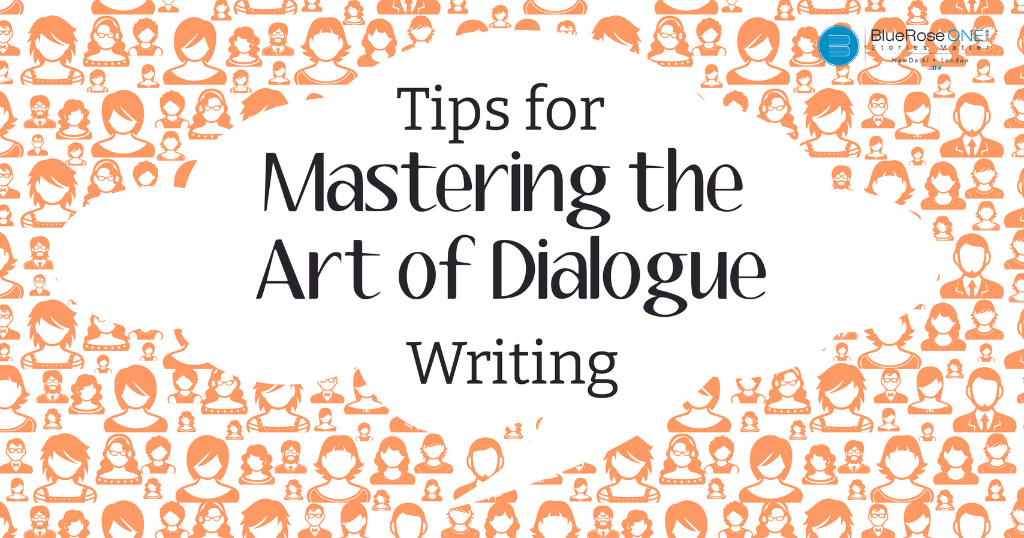Effective dialogue is the lifeblood of any engaging piece of writing, be it a novel, a short story, or a screenplay. It’s the vehicle through which characters find their voices, stories come to life, and readers or viewers become immersed in the narrative. In the hands of a skilled writer, dialogue has the power to captivate, evoke emotion, and drive the plot forward.
Many readers can recall their favourite literary or cinematic moments, not by long-winded descriptions or elaborate settings, but by the words that were spoken. These dialogues resonate because they were carefully crafted to reveal character, convey meaning, and stir emotions.
Whether you’re an aspiring writer or a seasoned author looking to refine your craft, understanding the art of dialogue is essential. It’s not just about the words characters speak; it’s about the subtext, the unsaid, and the emotions that lie beneath the surface. In this blog, we will delve into ten invaluable tips that can help you master the art of writing compelling and authentic dialogue.
Read: How to Overcome Writer’s Block: 10 Proven Ways to Unlock Your Creativity
To write effective dialogue is to become a playwright, a psychologist, and a storyteller, all rolled into one. It’s about understanding your characters so deeply that their words become an extension of their very being. It’s about listening to the rhythms and nuances of real conversations, ensuring your dialogue feels genuine and relatable.
The power of well-crafted dialogue cannot be overstated. It’s the difference between a story that falls flat and one that comes alive. These ten tips will serve as your guide, offering insights into character development, pacing, subtext, and more. With practice and patience, you’ll develop the skills to breathe life into your characters and stories, creating a connection with your readers that will keep them turning the pages or glued to the screen.
So, whether you’re a novice wordsmith or a seasoned scribe looking to fine-tune your craft, let’s embark on a journey to uncover the secrets of mastering the art of dialogue in writing. Get ready to make your characters not just speak but come alive on the page.
- Understand Your Characters
- Eavesdrop and observe
- Show, don’t tell.
- Use subtext.
- Keep it concise.
- Pacing and Rhythm
- Use dialogue tags sparingly.
- Dialect and Accents
- Edit and revise
- Dialogue as Plot Driver
1. Understand Your Characters
Characters are the heart and soul of any story, and their dialogue should be a direct reflection of who they are. To write compelling dialogue, you need to intimately know your characters. This includes their backgrounds, beliefs, quirks, motivations, and more.
For example, consider the character of Sherlock Holmes in Sir Arthur Conan Doyle’s stories. His dialogue is marked by its logical precision, attention to detail, and occasional arrogance. This dialogue aligns with his character as a brilliant and analytical detective. Conversely, Dr. John Watson’s dialogue reflects his compassionate and steady nature. By understanding your characters at this level, you can ensure their dialogue is authentic and true to their unique identities.
You may also like: How to Make Book Design More Appealing to the Reader
2. Eavesdrop and observe
Writers are, by nature, keen observers of the world. To craft convincing dialogue, it’s crucial to pay attention to real conversations and interactions around you. Eavesdropping discreetly on people’s discussions in various settings, from coffee shops to public transportation, can provide invaluable insights into how people speak, gesture, and respond to one another.
For instance, you might overhear a conversation at a bookstore where a customer passionately recommends a novel to a fellow reader. This genuine enthusiasm and persuasive tone can be integrated into a character’s dialogue when they are discussing their favourite book. The authenticity you gain from such observations enriches your writing and makes the dialogue relatable.
3. Show, don't tell.
One of the cardinal rules of writing applies to dialogue as well: show, don’t tell. This means that instead of directly stating a character’s emotions or intentions, you should use their words and actions to convey these elements.
For example, in a story about a character dealing with grief, rather than having them say, “I’m sad,” you can illustrate their sadness through their behavior. They might avoid eye contact, speak in a subdued tone, or lose interest in activities they once enjoyed. By showing these manifestations of sadness, you allow readers to empathise with and connect with the character on a deeper level.
4. Use subtext.
Subtext is the layer of unspoken meaning beneath a character’s spoken words. It adds depth and complexity to dialogue by implying thoughts, emotions, or intentions that are not explicitly expressed. Subtext can create tension, intrigue, and ambiguity.
Imagine a scene in which two characters, Alice and Bob, are discussing a recent breakup. Alice says, “I hope you find happiness.” On the surface, this may seem like a kind sentiment, but the subtext might convey her lingering bitterness and disappointment in a more profound way. This unspoken tension between the characters adds depth to their interaction and intrigues the reader.
You may also like: Never Say Goodbye a Book By Hilary Green
5. Keep it concise.
Concise dialogue is typically more effective in conveying meaning and maintaining reader engagement. Real-life conversations often involve succinct and focused statements. Unless a character’s personality or the context of a scene warrant verbosity, it’s advisable to keep dialogue concise.
For instance, if a character is delivering a critical piece of information to their team during a high-stakes mission, they wouldn’t provide an extensive backstory or use overly complex language. They’d deliver the information succinctly, emphasising its urgency and importance. This concise dialogue reflects the fast-paced nature of the situation and keeps readers engaged in the unfolding action.
6. Pacing and Rhythm
Pacing and rhythm in dialogue are essential for controlling the flow and mood of your narrative. By varying the tempo of your character interactions, you can effectively convey tension, emotion, and character development.
For example, in a high-stakes action scene, rapid-fire dialogue and short, urgent sentences can create a sense of urgency and chaos. This pacing keeps readers on the edge of their seats as they feel the characters’ panic and adrenaline.
On the other hand, a slower, introspective dialogue can be employed when delving into a character’s inner thoughts or in quieter moments. A deep, meaningful conversation between two characters, discussing their past regrets or future aspirations, can benefit from a slower pace, allowing readers to connect with the characters on a more profound level.
7. Use dialogue tags sparingly.
Dialogue tags serve the essential purpose of attributing speech to specific characters and ensuring clarity in conversations. However, overusing them can be distracting and disrupt the flow of dialogue. To avoid this, incorporate action beats and character descriptions within your dialogue to attribute lines to the right speakers.
For instance, instead of writing, “He said, ‘I can’t believe it,'” you can use an action beat: ” He leaned in, eyes wide. ‘I can’t believe it!'” This action not only identifies the speaker but also conveys their surprise and excitement.
Additionally, character descriptions can work effectively to avoid redundancy. Consider a dialogue between two best friends, Sarah and Emily. Instead of repeatedly using dialogue tags, you can use character descriptions to make it clear who is speaking. Sarah rolled her eyes. ‘You’re always running late,’ she teased. “Here, the action and character description convey the speaker without the need for a dialogue tag.
You may also like: The Importance of Professional Editing in Self-Publishing
8. Dialect and Accents
Writing characters with distinct dialects or accents can add depth and authenticity to your story. However, it’s essential to use them judiciously to avoid overwhelming readers. Instead of transcribing heavy accents phonetically, sprinkle in hints and subtleties that capture the essence of the character’s way of speaking.
For example, if you have a character with a Southern accent, you can occasionally use phrases or colloquialisms unique to that region. “Well, I do declare that pie is as sweet as a Georgia peach,” subtly conveys the character’s accent without making the dialogue difficult to read.
Remember that clarity is paramount, and readers should not struggle to understand the dialogue. A delicate balance between authenticity and readability is the key when incorporating accents or dialects.
9. Edit and revise
Effective dialogue often emerges through the editing process. After drafting a scene, it’s crucial to revisit the dialogue to refine and enhance it. Reading the dialogue aloud can help you identify awkward or unnatural phrasing.
As you edit, focus on eliminating redundancies, ensuring consistency in character voices, and confirming that the dialogue aligns with the story’s tone and objectives. Dialogue that initially feels forced or stilted can be revised to flow more naturally and authentically.
For example, if you find that a character’s lines come across as overly formal in a casual conversation, you can adjust the dialogue to match the character’s personality and the context. This revision process allows you to fine-tune your dialogue, making it more engaging and believable.
10. Dialogue as Plot Driver
Effective dialogue is not just an ornament but a potent driver of the plot. Dialogue should have a purpose and contribute to the advancement of the narrative. It can reveal critical information, introduce conflicts, and propel the story forward.
For instance, imagine a mystery novel where a detective questions a suspect. The suspect’s evasive and contradictory responses create tension and suspicion, driving the plot forward as the detective works to unravel the truth. In this case, the dialogue is not a mere conversation but a strategic tool for building intrigue and moving the story in a specific direction.
Whether it’s characters sharing secrets, uncovering clues, or engaging in heated debates, the dialogue should always serve the broader narrative. Avoid unnecessary chatter and ensure that every conversation contributes to the plot’s development and the readers’ engagement
Read: How Much Should My Book Cost? 7 Tips for Pricing Your Book
In conclusion, mastering the art of dialogue in writing is a skill that can elevate your storytelling to new heights. It serves as a powerful tool for engaging readers, developing characters, and advancing your plot. By understanding your characters deeply, observing real conversations, showing rather than telling, using subtext, and keeping dialogue concise, you can create compelling and authentic interactions in your stories.
Furthermore, the judicious use of dialogue tags, handling dialects and accents with care, diligent editing and revision, and leveraging dialogue as a plot driver are all essential elements in crafting effective dialogue. These tips provide you with the tools to make your characters come alive and your narratives more immersive.
Writing exceptional dialogue is an ongoing journey of exploration and refinement. It requires practice, a keen ear for real-life conversations, and a commitment to understanding your characters on a profound level. With dedication and perseverance, you can breathe life into your characters and stories, creating a dynamic and engaging reading experience for your audience. So, embrace the art of dialogue in your writing and let your characters speak their truths, enhancing your storytelling in the process.
You may also like: Online Books vs. Traditional Books | Pros and Cons
















